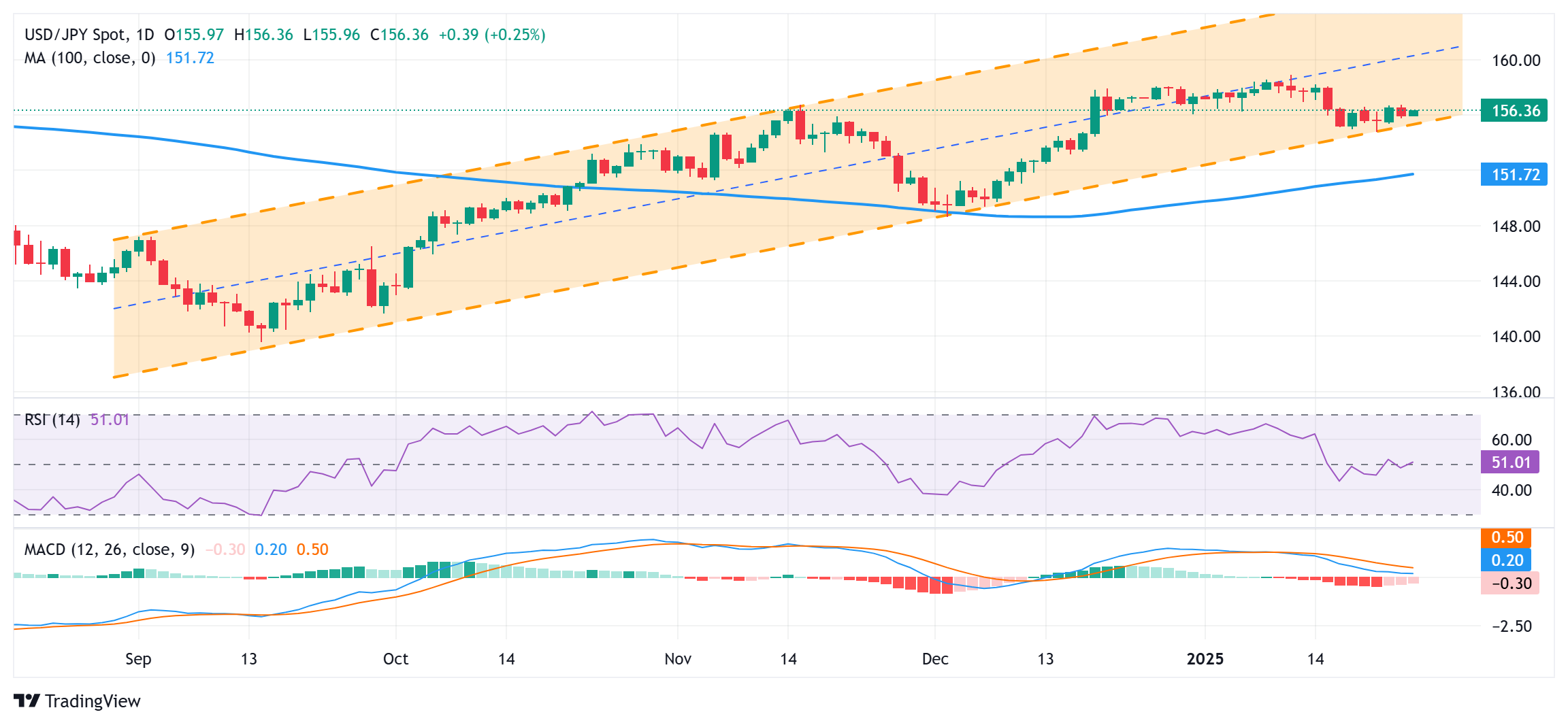Japanese Yen retreats slightly after BoJ Governor Ueda's comments; bullish bias remains
- The Japanese Yen catches aggressive bids in reaction to the BoJ's hawkish rate hike.
- BoJ's Ueda reiterated that the central bank will keep adjusting the degree of easing.
- The US Dollar hangs near the monthly trough and weighs on the USD/JPY pair.
The Japanese Yen (JPY) trims a part of strong intraday gains following the Bank of Japan (BoJ) Governor Kazuo Ueda's opening remarks during the post-meeting press conference, lifting the USD/JPY pair back closer to mid-155.00s in the last hour. Any meaningful JPY pullback, however, seems elusive in the wake of the BoJ's hawkish rate hike earlier this Friday. Moreover, hopes that spring wage negotiations will result in strong hikes again this year, and allow the BoJ to tighten its policy further, should continue to underpin the JPY.
In contrast, the markets have been pricing in the possibility that the Federal Reserve (Fed) will lower borrowing costs and the bets were lifted by US President Donald Trump's call for lower interest rates. This, in turn, triggers a fresh leg down in the US Treasury bond yields, which, along with the BoJ's hawkish outlook, support prospects for the narrowing of the US-Japan yield differential and should support the lower-yielding JPY. Apart from this, some follow-through US Dollar (USD) selling should cap the upside for the USD/JPY pair.
Japanese Yen retains its bullish bias amid bets for further BoJ rate hikes
- The Bank of Japan decided to raise interest rates by 25 basis points, the biggest rate hike since February 2007, from 0.25% to 0.50%, or the highest since the 2008 global financial crisis.
- BoJ reiterated that it will continue to raise the policy rate and adjust the degree of monetary accommodation if the outlook presented in the January Outlook Report will be realized.
- Moreover, expectations that springtime wage negotiations would yield bumper wage hikes again in 2025 and the boadening inflation in Japan gives the BoJ more impetus to hike rates further.
- BoJ Governor said that real interest rates remain significantly negative and that the timing and scope of further rate hikes will depend on the economy, financial, and price conditions.
- Data released by the Japan Statistics Bureau this Friday showed that the National Consumer Price Index (CPI) climbed 3.6% YoY in December, compared to the previous month's reading of 2.9%.
- Further details of the report revealed that Japan's core consumer prices rose in line with expectations, from 2.7% to 3.0% during the reported month – marking its highest level since mid-2023.
- Adding to this, a core reading, which strips out the effect of both fresh food and energy prices, remained steady and rose 2.4% in December from a year earlier amid strong private consumption.
- The BoJ also raised its inflation forecast and do not expect the CPI to drop back under its 2% annual target anytime soon.
- The preliminary Purchasing Managers' Index (PMI) showed that manufacturing activity in Japan contracted for the seventh straight month in January, while services sector activity picked up.
- Meanwhile, US President Donald Trump, speaking remotely at the World Economic Forum in Davos, said on Thursday that he will apply pressure on the Federal Reserve to bring down interest rates.
- This comes on top of signs of easing inflationary pressures in the US and reaffirms bets that the Fed will lower borrowing costs twice this year, which keeps the US Dollar close to the monthly low.
- Traders on Friday will also confront the release of flash PMIs, which could provide a fresh insight into the global economic health and might influence demand for the safe-haven Japanese Yen.
USD/JPY could accelerate the fall one the 155.00 mark is broken decisively

From a technical perspective, the USD/JPY pair, so far, has managed to defend support marked by the lower end of a multi-month-old ascending channel, currently pegged near the 155.35 area. This is closely followed by the 155.00 psychological mark and the 154.80-154.75 region, or over a one-month low touched on Tuesday. Some follow-through selling below the latter will be seen as a fresh trigger for bearish traders and drag spot prices to the 154.00 round figure en route to the mid-153.00s and the 153.00 mark.
On the flip side, the overnight swing high, around the 156.75 area, could offer some resistance ahead of the 157.00 round figure. A sustained strength beyond the latter should pave the way for a further move up towards the 157.55 area en route to the 158.00 mark. The momentum could extend further towards the 158.35-158.40 region, above which the USD/JPY pair could retest the multi-month peak, around the 159.00 neighborhood touched on January 10.
Japanese Yen FAQs
The Japanese Yen (JPY) is one of the world’s most traded currencies. Its value is broadly determined by the performance of the Japanese economy, but more specifically by the Bank of Japan’s policy, the differential between Japanese and US bond yields, or risk sentiment among traders, among other factors.
One of the Bank of Japan’s mandates is currency control, so its moves are key for the Yen. The BoJ has directly intervened in currency markets sometimes, generally to lower the value of the Yen, although it refrains from doing it often due to political concerns of its main trading partners. The BoJ ultra-loose monetary policy between 2013 and 2024 caused the Yen to depreciate against its main currency peers due to an increasing policy divergence between the Bank of Japan and other main central banks. More recently, the gradually unwinding of this ultra-loose policy has given some support to the Yen.
Over the last decade, the BoJ’s stance of sticking to ultra-loose monetary policy has led to a widening policy divergence with other central banks, particularly with the US Federal Reserve. This supported a widening of the differential between the 10-year US and Japanese bonds, which favored the US Dollar against the Japanese Yen. The BoJ decision in 2024 to gradually abandon the ultra-loose policy, coupled with interest-rate cuts in other major central banks, is narrowing this differential.
The Japanese Yen is often seen as a safe-haven investment. This means that in times of market stress, investors are more likely to put their money in the Japanese currency due to its supposed reliability and stability. Turbulent times are likely to strengthen the Yen’s value against other currencies seen as more risky to invest in.
Forex News
Keep up with the financial markets, know what's happening and what is affecting the markets with our latest market updates. Analyze market movers, trends and build your trading strategies accordingly.
